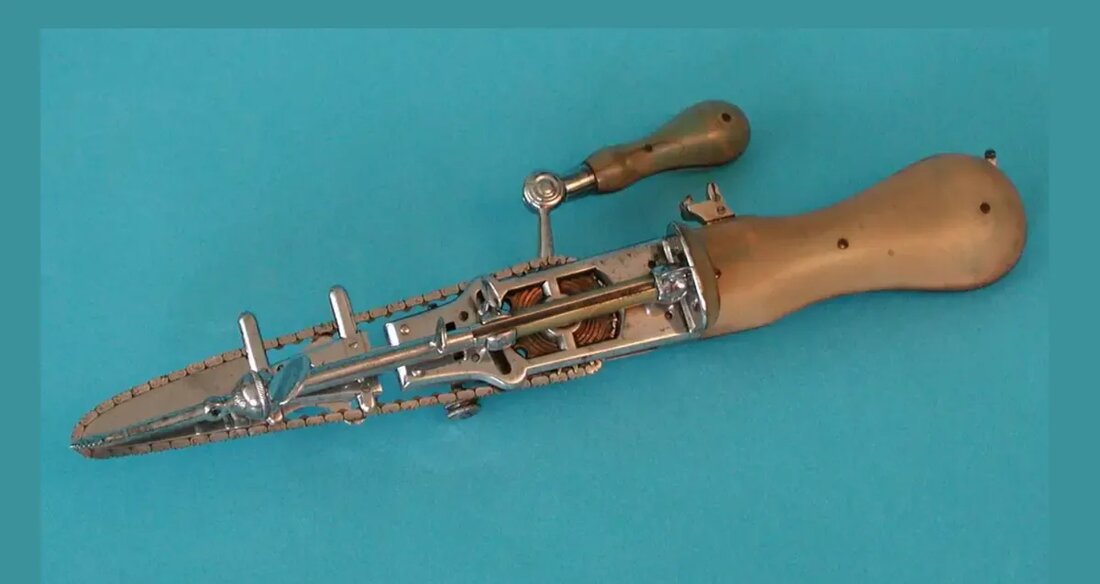The shocking truth: Chainsaws were originally designed for childbirth, before the age of hygiene and antibiotics began
Prepare for a shocking revelation: The chainsaw, a tool commonly associated with felling trees, was originally designed to aid in childbirth by hacking at the pelvic area. This shocking truth reveals a dark chapter in the history of medical procedures before the advent of hygiene and antibiotics. The Origin of the Chainsaw in Childbirth Contrary to popular belief, the chainsaw was originally invented as a medical tool to facilitate childbirth. In particular, it was used in a highly dangerous and now outdated procedure called symphysiotomy, in which the cartilage lining the left...

The shocking truth: Chainsaws were originally designed for childbirth, before the age of hygiene and antibiotics began
Prepare for a shocking revelation: The chainsaw, a tool commonly associated with felling trees, was originally designed to aid in childbirth by hacking at the pelvic area. This shocking truth reveals a dark chapter in the history of medical procedures before the advent of hygiene and antibiotics.
The origin of the chainsaw at birth
Contrary to popular belief, the chainsaw was originally invented as a medical tool to facilitate childbirth. In particular, it was used in a highly dangerous and now outdated procedure called symphysiotomy, in which the cartilage connecting the left and right pelvic bones was severed, thereby widening the pelvis for easier delivery.
Childbirth has always been fraught with challenges, but it was even more daunting in the days before nitrous oxide, proper hygiene and the widespread use of morphine. The first documented report of a successful cesarean section (cesarean section) comes from Switzerland in the 16th century, when a professional cow castrator allegedly performed the operation on his wife. The legitimacy of this report, recorded 82 years later, is debated among historians. However, it is said that both the mother and child survived, with the child living to be 77 years old.
In the United States, the earliest published record of a cesarean section is far more gruesome. In an 1830 issue of the Western Journal of Medical and Physical Sciences, Dr. John L. Richmond on the case of a difficult birth during a storm. Since labor did not occur and the woman's life was in danger, the doctor decided to perform a cesarean section using only a set of standard pocket instruments. Using curved scissors, he cut into the mother, but complications arose due to the size of the fetus and the mother's significant body fat. Ultimately, he decided to save the mother at the cost of the child's life. This narrative highlights the immense risks and rarity of cesarean sections before the availability of antiseptics and anesthetics.
The Invention of the Chainsaw Between 1597 and the advent of safe cesarean sections, symphysiotomies were performed more frequently. This procedure involved cutting the pubic symphysis, a cartilage joint above the vulva, to enlarge the pelvis and make childbirth easier. As with other operations of the period, the risks were high, and speed was essential to minimize the chance of shock or fatal infection.
At the end of the 18th century, Scottish doctors John Aitken and James Jeffray developed a more efficient solution: the world's first chainsaw. Inspired by a watch chain, this flexible saw features teeth that are moved by a hand crank, significantly speeding up the process. Despite the grisly image of a doctor operating a chainsaw on the pelvic area, the device, manufactured in 1806, was considered a vast improvement. It was later used to remove diseased joints and was eventually mechanized.
It wasn't until 1905 that the chainsaw's potential for felling trees was realized.
The Evolution of Obstetric Care for Women Over the centuries, advances in medical science have greatly improved the care and safety of women during childbirth. The development of antiseptics, antibiotics, and anesthetics has dramatically reduced the risks associated with cesarean sections and other birth-related procedures. In addition, the establishment of professional guidelines and specialized training of obstetricians and midwives have further improved the standard of care for expectant mothers.
It is a testament to humanity's progress that the chainsaw, once a terrible birthing tool, has now been relegated to the realm of tree felling and woodworking.
Sources:
- (Link entfernt)
- (Link entfernt)
- Image credit: Sabine Salfer/Orthopädische Universitätsklinik Frankfurt/Public Domain

 Suche
Suche
 Mein Konto
Mein Konto
